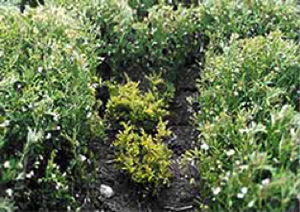Managing viruses in pulse crops
Management strategies are available to minimise the impact of viruses on the growth and yield of pulse crops. Maximising growth and production of pulse crops will ensure they deliver the highest level of benefit to cropping systems.
Pre-season management
Rainfall in summer and autumn has a major effect on virus infections in crops. High rainfall during this period leads to a build up of weed hosts for viruses and the growth of self sown pulses. Aphids, which are the means of transmission or spread of viruses, are also favoured by a wet summer and autumn. These conditions can lead to an early infection which can then have a major impact on growth and yield.
It is therefore important to observe the season and make a decision if the risk is potentially high. If the season is considered high risk it is important to control weeds and self sown crops early, and certainly before they can support a population of aphids. This will be well prior to sowing pulses.
Selection of high quality seed is also important. A number of common viruses are seedborne. These viruses include:
- alfalfa mosaic virus (AMV)
- cucumber mosaic virus (CMV)
- pea seedborne mosaic virus (PSbMV)
- bean yellow mosaic virus (BYMV).
Purchase virus-tested seed or have farmer seed virus-tested.
At the very least select seed from a crop which has no virus symptoms and no evidence of aphids, although this does not guarantee freedom from viruses.
AMV, CMV and BYMV have wide host ranges and can also be brought into a crop by aphids. However, PSbMV is generally only spread from infected seed, therefore use of virus tested seed provides very good control of this virus.
Sowing practices
 Flying aphids have been shown to prefer plants surrounded by bare ground. It is important to use practices that promote good ground cover and canopy development to reduce bare ground as quickly as possible.
Flying aphids have been shown to prefer plants surrounded by bare ground. It is important to use practices that promote good ground cover and canopy development to reduce bare ground as quickly as possible.
This means early sowing, when the season permits, is critical. Sowing at high density, using narrow row spacing, will also aid rapid ground cover being achieved.
Retaining stubble is also beneficial in achieving ground cover and may be important where wider row spacing is adopted.
As plants establish, healthy, rapidly growing plants tend to shade out weak virus infected plants, thus preventing aphids feeding on them and spreading virus.
Management after emergence
Monitoring for the presence of aphids and applying insecticides early has been shown to reduce the incidence of yellowing caused by persistently transmitted luteoviruses such as turnip yellows virus (TuYV) and bean leafroll virus (BLRV) in a range of crops.
Insecticide application may be required every 2-4 weeks.
If crawling aphids are moving into the crop from adjacent paddocks then a border spray may be adequate to control them. Most common pulse viruses may be spread in this way if adjacent paddocks contain virus hosts.
Local agronomists and chemical resellers can usually provide good advice on insecticide use.
Monitoring in the growing season
Monitoring for the presence of aphids is important throughout the winter and early spring and, as appropriate, control measures can be adopted.
Black cowpea aphids are usually easy to see while other species may not be so obvious, particularly on lentils. To aid monitoring, a white sheet of paper or something similar is useful to hold under a plant and shake the leaves. Small aphids will be more visible when they fall onto the white background.
Symptoms of virus infection will also become more obvious as the season progresses. Generally infected plants will look yellow and stunted and may have stiffened cupped leaves. Closer observation may reveal patchy mosaic leaf symptoms. Early in the season, symptoms, if present, will be randomly distributed in the crop. If aphids are not controlled, patches of infected plants may develop.
If symptoms are suspected it is important to seek advice on the identity of the virus as insecticides are only effective in managing luteoviruses such as TuYV and BLRV.
Harvest planning
It is important to remember that some viruses are seedborne and seed from an infected crop is not suitable for resowing. These viruses include AMV, CMV, PSbMV and BYMV.
Yellowing viruses are not seedborne and seed may be kept for sowing. These include BLRV, TuYV and subterranean clover stunt virus (SCSV).
It is therefore important to consider observations and assessments, and possibly virus testing, during the season to determine which crops may be suitable to be held as seed.
Further references
- Pulse Australia
- Pulse Disorders: The Ute Guide
- Victorian Winter Crop Summary
- Seed Health Testing in Pulse Crops
- Temperate Pulse Viruses: Alfalfa Mosaic Virus (AMV)
- Temperate Pulse Viruses: Bean Leafroll Virus (BLRV)
- Temperate Pulse Viruses: Cucumber Mosaic Virus (CMV)
- Temperate Pulse Viruses: Bean Yellow Mosaic Viruses (BYMV)
- Temperate Pulse Viruses: Pea Seedborne Mosaic Virus (PSbMV)
Contact
Dr Piotr Trebicki
Virologist – Horsham
03 5450 8301
Field Crops Pathology
Grains Innovation Park
110 Natimuk Rd
Horsham 3400
03 5450 8301
Or call the Customer Service Centre, 136 186
Acknowledgments
Angela Freeman. Support by the Grains Research and Development Corporation is gratefully acknowledged.